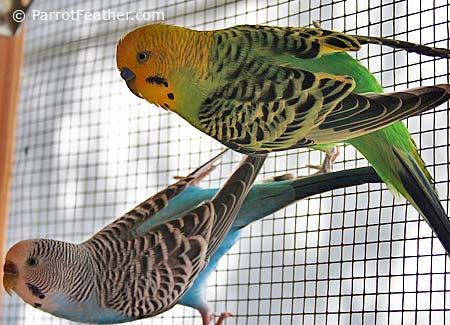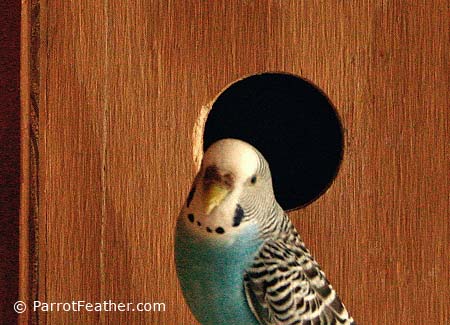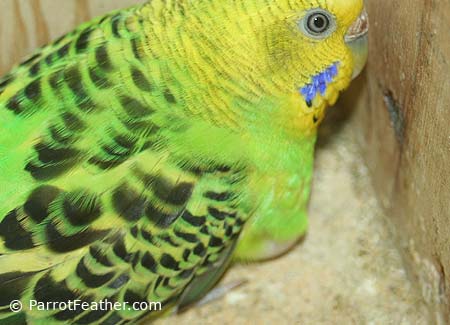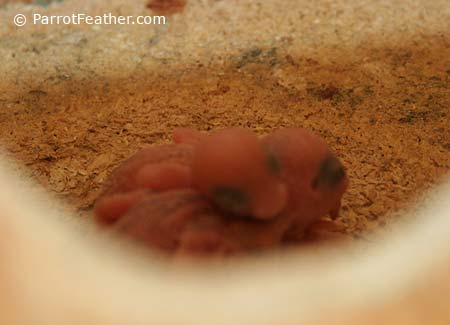[bars]
Selecting a Budgie Pair

If you are going to breed, it is important to select a healthy pair of Budgies. The pair should have no respiratory problems, healthy plumage, and no nasal or eye discharges. A healthy Budgie will also be alert and active. A Budgie with ruffled feathers and sitting alone from flock members should not be used. If there is no reaction towards humans, avoid considering him as a breeder bird. Also, young Budgies should not be used. They can easily develop problems if forced into breeding very early. For example, a young hen that is forced into breeding can develop many complications such as being egg bound (an illness that does not allow the female to pass the egg and usually results in death). Young males will be infertile.
[ads]
Picking mature parakeets for your breeding program can be done by following these three rules.
The eyes of mature parakeets will exhibit yellow irises.
Their beaks will be solid colors of brown, beige, or tan. Young Budgies will have small patches of black on their beaks.
The cere, or skin above the nose or nostrils, will not be pink. A male Budgie’s cere will be blue and a female’s will be brown.
If the age of the Budgie is still not evident or you are unsure, ask the breeder who sold you the bird. Most breeders keep detailed records of their birds.
Parrot Supplies

When choosing the right supplies for your Budgie, be sure to think ahead. Thinking ahead means using equipment that can easily be cleaned and disinfected. A breeding cage should be used with trays that can be removed, a grill to avoid the birds from stepping on their feces, and doors for easy access.
The nesting box should be chosen carefully. The ideal box is one that can be hung outside the cage for easy access to the babies. A breeder often needs to band the chick’s legs and observe the development of the babies. A nesting box that is hung inside the cage should not be used. These boxes are quickly used as platforms for the courting parents, and as a result, covered with feces.
The bedding of the nesting box is also important. It provides traction for the babies and prevents any growth deformities such as splayed legs (legs that grow outward rather then their natural position). The bedding should be cedar or pine shavings. Some breeders choose to change the bedding once the chicks start to feather out; however, this can cause the mother to abandon the nest. If the bedding is changed, it is important to block the entrance hole so the mother cannot enter the nesting box. Place the babies inside a brooder and quickly remove the bedding and scrape out any droppings. When the nesting box is clean, put the babies back and keep an eye on them to ensure the mother has resumed her duties.
The perches and dishes should also be arranged correctly. Bowls should not be placed under perches and perches not above bowls. Contaminated food and water can cause serious croup infections with the chicks.
Budgie Courting and Mating
Once the Budgies have been selected and the proper equipment has been purchased, the birds should start to court. During the courting process, the male Budgie will start to vocalize and dance. This dance and ritual consists of the throat feathers ruffling up, bobbing of the head, and walking back and forth near his mate. This dance excites the female and she begins looking for a cavity to nest. This process will repeat until the female allows the male to mate with her.
When the female parakeet is ready to mate, her head will arch back, her wings will slightly open, and her eyes will pin. The male will mount the female and copulating will begin. The female will usually lay her eggs a day or two after mating.
Budgie Incubating and Hatching

The clutch can consist of two to six eggs. Some females will lay more; however, any more than six should be removed. During the duration of the incubation, which is 18 days, the male will feed the hen while she sits. Some males will sit inside the box with the hen. Around 16 or 17 days into incubation, the eggs will have small cracks made by the chicks (called the pip hole). This means hatching can be expected shortly. The chicks are likely to hatch 24 hours after the first pip hole.
Budgie Chicks

Once the chicks hatch, the mother will sit on them. She will begin feeding them a few hours after hatching. The food she feeds them is a concoction of enzymes and cells packed with nutrients to help develop their immune systems. During this period, the chicks will experience rapid growth and will soon start to feather as the weeks pass. The father will asset in feeding the chicks as well. As they get older and can produce their own heat, the female will spend more hours outside the nesting box. During this time, feed the parents a variety of soft foods such as corn, crushed boiled eggs, and pellets.
Around four weeks, the babies will be curious and peek outside their nesting box. Most start exploring their surroundings and some babies will not leave the box until five weeks. Once the chicks are confident enough to step outside the box, the female and male will encourage them to fly. These babies are now called fledglings and can depend on their parents for up to 7 weeks before they are weaned (eating of their own).
After the chicks are completely independent, they should be removed and placed into a flight cage. The used nesting box should immediately be cleaned and put away until you decide to breed again. Parakeets should be allowed to breed twice a year followed by a years break afterwards.
[ads]
